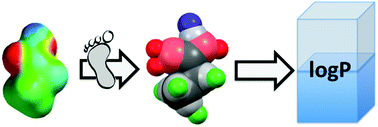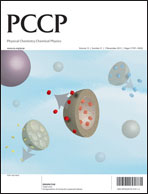Footprinting molecular electrostatic potential surfaces for calculation of solvation energies†
Abstract
A liquid is composed of an ensemble of molecules that populate a large number of different states, so calculation of the solvation energy of a molecule in solution requires a method for summing the interactions with the environment over all of these states. The surface site interaction model for the properties of liquids at equilibrium (SSIMPLE) simplifies the surface of a molecule to a discrete number of specific interaction sites (SSIPs). The thermodynamic properties of these interaction sites can be characterised experimentally, for example, through measurement of association constants for the formation of simple complexes that feature a single H-bonding interaction. Correlation of experimentally determined solution phase H-bond parameters with gas phase ab initio calculations of maxima and minima on molecular electrostatic potential surfaces (MEPS) provides a method for converting gas phase calculations on isolated molecules to parameters that can be used to estimate solution phase interaction free energies. This approach has been generalised using a footprinting technique that converts an MEPS into a discrete set of SSIPs (each described by a polar interaction parameter, εi). These SSIPs represent the molecular recognition properties of the entire surface of the molecule. For example, water is described by four SSIPs, two H-bond donor sites and two H-bond acceptor sites. A liquid mixture is described as an ensemble of SSIPs that represent the components of the mixture at appropriate concentrations. Individual SSIPs are assumed to be independent, so speciation of SSIP contacts can be calculated based on properties of the individual SSIP interactions, which are given by the sum of a polar (εiεj) and a non-polar (EvdW) interaction term. Results are presented for calculation the free energies of transfer of a range of organic molecules from the pure liquid into water, from the pure liquid into n-hexadecane, from n-hexadecane into water, from n-octanol into water, and for the transfer of water from pure water into a range of organic liquids. The agreement with experiment is accurate to within 1.6–3.9 kJ mol−1 root mean square difference, which suggests that the SSIMPLE approach is a promising method for estimation of solvation energies in more complex systems.


 Please wait while we load your content...
Please wait while we load your content...